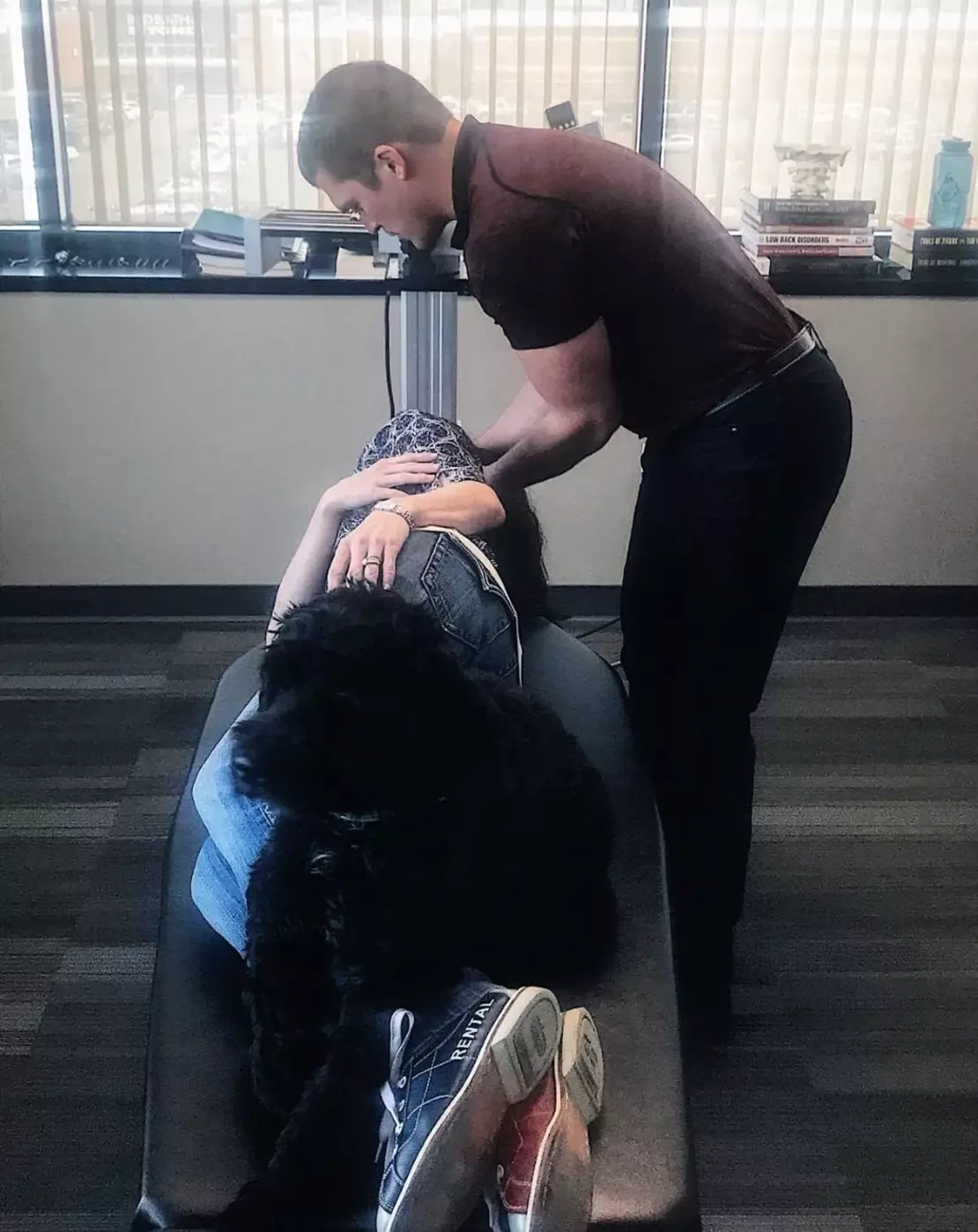Dealing with middle back pain? Symptoms, Causes, Treatments
Exploring the Unique Causes of Headaches in Denver and How Chiropractic Care Provides Relief
We often hear a lot about neck pain or lower back pain, but middle back pain is relatively common , too. Middle back pain can be just as disruptive to daily life as other types of back pain. Luckily, there are many effective ways to treat middle back pain and get “back” to normal.
What is middle back pain?
Middle back pain is pain that you feel in your back between your shoulders and the bottom of your ribs. It can happen for several reasons, and in some cases, you may not know why your back is hurting.
The back can be broken down into two major parts: the sides of your back (primarily muscles, connective tissue, and skin) and the spine. The spine can be further broken down into 4 major sections:
- Cervical spine , located in the neck
- Thoracic spine , located in the middle and upper back, which attaches to the rib cage
- Lumbar spine , located in the lower back
- Sacral spine , which includes part of the pelvis called the sacrum and the tailbone (coccyx)
One reason you may be having middle back pain is an issue with your spine. The spine protects the spinal cord and the nerves that run from the cord to the rest of the body. It also provides the structural support that allows the body to stand upright.
The spine is made up of bones, called vertebrae, separated by cushiony intervertebral discs that absorb pressure and impact to the vertebrae. It’s also connected to muscles and ligaments that hold the spinal column together and integrate with other parts of the body.
Middle back pain can be caused by problems with any of these parts of the back or a combination of several of them. It’s important to find a healthcare provider who takes the time to find the root cause of your back pain, not just slap a bandage on the pain itself.
What should I do if I have middle back pain? If you have persistent or severe middle back pain, call your healthcare practitioner to determine the root cause. If you experience chest pain, jaw pain, leg muscle weakness or paralysis, or a loss of bladder control along with your back pain, call 911.
Symptoms
The most common symptom of middle back pain is pain in the area between your shoulders and the bottom of your ribs. You could feel sharp pain or a dull ache , and the pain may be chronic or acute, depending on the root cause of the pain.
In addition to pain symptoms, you may also experience muscle stiffness or a feeling that the joints of your spine are stiff. Some patients will experience their back pain as a burning sensation.
Patients with middle back pain also often experience low back pain , shoulder pain, and/or neck pain because muscles and connective tissue are linked all up and down the back.
What are the symptoms of pain in the middle of the back? The symptoms of pain in the middle of the back are pain (dull or sharp), aches, burning sensations, or stiffness in the middle part of the back.
What causes middle back pain?
Middle back pain can be caused by almost every part of the back, including muscles, nerves, and bones. There are some underlying causes of middle back pain more common than others, which we’ll briefly cover here.
What is middle back pain a symptom of? Middle back pain is a symptom of many conditions, including herniated discs, spinal stenosis, pinched nerves, bad posture, osteoporosis, arthritis, or injuries.
One of the most common causes of middle back pain is sitting or standing with poor posture all day. If you spend most of the day hunched over a computer, your slouching posture is almost certainly contributing to your back pain.
Occasionally, the discs between the vertebrae can become herniated. This means the squishy inner part of the disc pushes out through a tear in the tough outer cartilage of the disc. Herniated discs put extra pressure on the nerves coming out of the spine, causing pain or numbness.
Disc degeneration can also cause middle back pain. In conditions such as degenerative disc disease, the discs become inflamed, which can produce severe pain. Similarly, osteoarthritis of the spine involves the breakdown of discs and can cause a lot of back pain.
Damage to the bones of the spine is another common cause of middle back pain. When the vertebrae are damaged, they can put pressure on the spinal cord or the nerves coming out of the spine. This can lead to pain, numbness, and general discomfort.
Osteoporosis is one of the most common reasons vertebrae break down or become damaged. Weakened vertebrae can develop compression fractures and other fractures that are quite painful and debilitating.


Sports injuries, car accidents, or other acute injuries can easily lead to back pain. Trauma to the spine or muscles in the middle back results in ongoing pain until the injury heals.
Patients may also experience overuse injuries, muscle strains, and sprains that cause back pain.
Some middle back pain occurs when the nerves in the lower back become irritated or injured. Pinched nerves, spinal stenosis (narrowing of the spinal canals that nerves run through), and other anatomical changes or injuries can lead to nerve pain in the back.
Conditions that cause chronic pain in the muscles, like fibromyalgia or lupus, can also lead to back pain.
The pain associated with these conditions isn’t usually confined to the back, and these patients generally experience pain all over the body.
Scoliosis occurs when the spine develops with an abnormal curve, which can lead to back pain. Depending on its severity, scoliosis can be pretty painful if it presses on the spinal discs or nerves.
Pregnant women frequently experience back pain due to a combination of the biomechanical forces put on their spine by the growing fetus and the loosening of their ligaments due to the relaxin hormone released during pregnancy.
What organs can cause mid-back pain? The kidneys and gallbladder are organs that can cause mid-back pain. Mid-back pain can be a symptom of kidney stones.

Diagnosis
You should seek medical advice for acute, recurring, or chronic middle back pain. A medical professional can make sure that the back pain isn’t caused by a potentially serious health condition, like a tumor.
Your medical professional will work to identify what is causing the back pain before prescribing a treatment. You may need x-rays or other scans of your spine to rule out fractures, problems with the spinal discs, or other potential issues with the vertebrae or discs.
Prevention
The best way to cope with middle back pain is to prevent it from happening in the first place. Some of the most effective ways to prevent back pain include:
- Sitting with good posture and taking frequent breaks if sitting or standing in the same position for a long time
- Preventative chiropractic care to address any problems before they become painful
- Protecting your spine when lifting and/or bending
- Avoiding situations that make you take sudden movements that can lead to muscle strains or sprains
- Sleeping on your side or on your back, which puts less pressure on the spine
- Strengthening the muscles in your core to protect your spine
- Getting regular massages to address any muscle tightness or imbalances that could lead to injury
Treatments
If you’re suffering from middle back pain, there’s good news: Back pain is very treatable in most cases. Effective treatments for middle back pain include:
- Chiropractic adjustments and care: Chiropractic adjustments help reposition the spine and address misalignments that can cause pinched nerves, nervous system dysfunction, and other health problems.
- Physical therapy: If you’re recovering from an injury or if your back muscles are causing your pain, physical therapy can be an effective treatment. Chiropractors also use many of the same techniques physical therapists use to treat back pain.
- Stretching: Stretching can help loosen tight muscles that contribute to back pain.
- Posture correction: Learning to sit, stand, and go about other daily activities with good posture can help alleviate the pressure on the middle back, which can reduce or eliminate back pain.
- Medication: Most traditional doctors will prescribe muscle relaxants and/or pain medication if your middle back pain is caused by muscle spasms or other muscle-related problems. Unfortunately, medication often doesn’t address the root cause of the issue and is generally just a stopgap measure.
- Icing and heat: Icing and/or heat therapy can help with back pain, depending on the root cause. Inflammation should be treated with cold therapy, and tight or sore muscles can be soothed with heat therapy.
The best treatment option for your middle back pain ultimately comes down to the reason why your back is hurting in the first place. Your treatment should address the root cause of your back pain.
How do you relieve middle back pain? You relieve middle back pain by treating the root cause of the pain, including chiropractic care, physical therapy, medication, or hot and cold therapy.
Chiropractic Care For Pain Relief
If you’re experiencing middle back pain, we can help. Dr. Ty Carzoli is an expert in solving back pain, including middle back pain, and provides top-notch chiropractic care.
Click here to schedule your appointment with Dr. Carzoli in the greater Denver area, or give us a call at 303-955-8270.
Sources:
- Briggs, A. M., Smith, A. J., Straker, L. M., & Bragge, P. (2009). Thoracic spine pain in the general population: prevalence, incidence and associated factors in children, adolescents and adults. A systematic review. BMC Musculoskeletal Disorders, 10 , 77. Abstract: https://pubmed.ncbi.nlm.nih.gov/19563667/
- Shiri, R., Karppinen, J., Leino-Arjas, P., Solovieva, S., & Viikari-Juntura, E. (2010). The association between obesity and low back pain: a meta-analysis. American Journal of Epidemiology, 171 (2), 135–154. Abstract: https://pubmed.ncbi.nlm.nih.gov/20007994/
The post Dealing with middle back pain? Symptoms, Causes, Treatments appeared first on Denver Upper Cervical Chiropractic.
© 2025 Denver Upper Cervical Chiropractic

